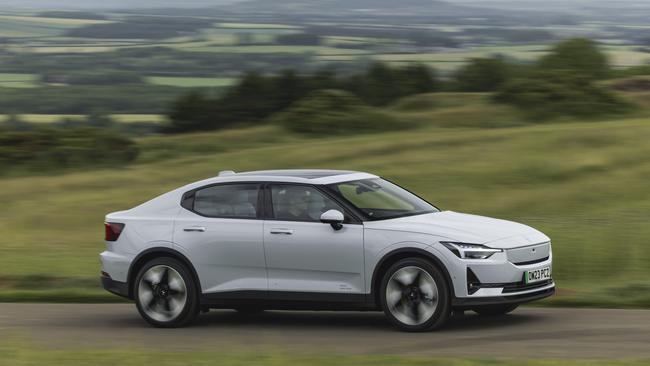Polestar 2 looks and feels better after big transformation
Anything that can be changed has been changed in Polestar 2, with a bigger, better battery, retuned suspension and a new and more efficient electric motor.

A vehicle’s midlife facelift is called that for a reason, given it is usually little more than a nip and tuck designed to keep a model feeling fresh against the competition, normally through some relatively inconsequential improvement.
But what has happened to the Polestar 2 for this Model Year 2024 (MY24) update goes way, way, beyond that. This is less a facelift and more like Face/Off, with the Swedish Tesla fighter driving into the workshop as John Travolta, and out as a leaner, meaner Nicolas Cage.
Honestly, anything that can be changed has been changed, at least under the skin, with a bigger, better battery, retuned suspension and a new and more efficient electric motor.
Oh, and it looks different, with a revised front end that’s now more in keeping with the brand’s new models that are coming soon.
Hell, there has even been a critical swap from being front to rear-wheel drive, for that sportier feel (there are still AWD versions, too, but we’re yet to sample the updated versions).
Why change so much? Partly because electric vehicle tech (like batteries and motors) moves fast, and with the brand now readying to launch several new models, there was plenty that could be filtered down to the brand’s entry-level car.
But there’s also a more philosophical reason. Polestar bills itself as an “electric performance” brand — and there are some properly fast models around the corner — so a modestly powered, front-wheel-drive version of the Polestar 2 was starting to stick out like a bicycle parked in a Comanchero club house carpark.
The brand says these updates see the Polestar 2 become what it should have been from the very beginning — a genuinely fun-to-drive EV that ties more neatly with the marque’s broader ethos.
We put that to the test in the Long range Single motor (uninventive naming, perhaps, but at least it’s easy to follow), which now produces 220kW and 490Nm — up from 170kW and 330Nm — and delivers a sprightly sprint to 100km/h of 6.2 seconds.
This car is yours for $71,400, before on-road costs and any subsidies. There’s also a Standard range Single motor ($67,400) which opens proceedings, a Long range Dual motor ($76,400), and the same with a Performance Pack ($85,400) that sits at the top of the tree. All have increased by around $3k over the model they replace.
The rear-drive swap makes a proper difference here. No real performance car, save some hot hatchbacks, send their power to the front tyres, with the reasons being two-fold.
First, the front tyres have enough to deal with, what with all the steering, without also having to accept all the power, too. And second, and more importantly, oversteer is way more fun (and controllable) than understeer, where too much power and speed when cornering can have you locked up and straight-lining towards a tree, and with very little you can do about it.
Our relatively short and very rain-slicked test through a handful of little UK villages was more sleepy than Silverstone, but even there the benefits were pretty clear, not the least the feeling of being pushed through a corner, rather than pulled out of one, when you stand on the accelerator.
The steering is good, too. Not overly sharp, as in some EVs, and with a heft and weight that makes your inputs feel deliberate, but still natural.
The ride remains tuned a little firm for some dodgier road surfaces, but it leads to a sportier-feeling drive that’s still somehow more supple than the model it replaces. There is still a sharpness there, though, so you need to know what you’re signing up for.
Inside, there have been no major changes. But the Polestar 2 is still a nice place to spend time. The cabin materials are lovely, the generally light hues used instil a little Scandinavian style, and the portrait-style central screen is clear and easy to use, too.
There are some drawbacks, though. The back seat is probably the tightest of any current EV, for example, with limited leg room and a somewhat claustrophobic air over longer journeys.
And, at $71,400, our model is considerably more expensive than its closest Tesla rival, the rear-drive Model 3 (which starts at under $60k), although our Polestar will travel further between charges, and there is the cheaper Standard range model that narrows the gap a bit.
Speaking of driving range, the brand says the new Polestar 2 can now travel up to 22 per cent further, consumes up to 9 per cent less energy, and charges up to 34 per cent faster.
In real terms, that means our test vehicle can travel up to 654km between charges, thanks to its new 82kWh battery, and can now accept 205kW DC fast charging, which will take you from 10 to 80 per cent charged in 28 minutes.
So, less a nip and tuck and more a full-body glow up for the Polestar 2. But the result of all this fettling is one of the better driving EVs on the market.


